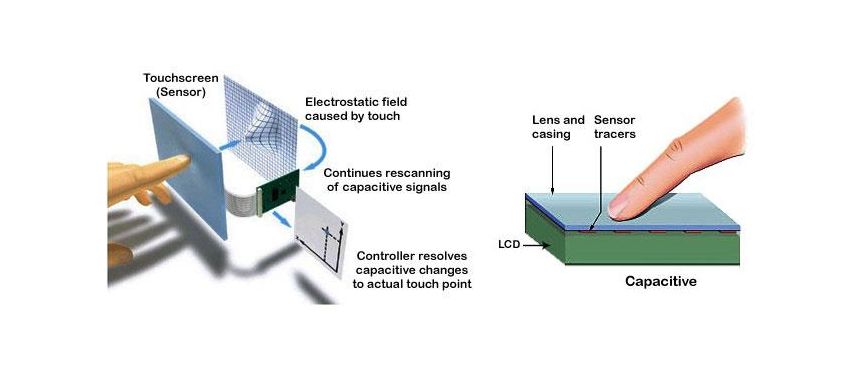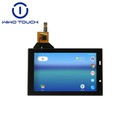Any system that uses touch screen technology has three main components that make the touch screen work:
Touch Sensor - The structure of the touch sensor depends on the type of touch screen we are using. Its job is to sense any valid touch, valid in the sense of touch by finger or hand.
Controller - The controller is a small PC card. It gives the location of the touch to the software of the device.
Software Driver - Software drivers allow the software to work with the touch screen. These drivers are developed using the C programming language.
There are many types of touch screens but the two most commonly used are as follows:
Resistive Touch Screens
It is the simplest and most commonly used touch screen. Resistive touch screen bends when pressed hard and resists touch, hence the name. It consists of two layers that can conduct electricity, the outer layer is resistive and the inner layer is conductive. These two layers are separated by small dots called spacers until the screen is touched. An electric current is constantly flowing through the two layers, and when a finger suddenly touches the screen, the two layers are pressed together and the current changes. The software of the device senses the change in this particular position and does its job meaning it implements the function corresponding to that position. Some advantages of this type are that it is reliable and durable. Some of the disadvantages of this type are that it is difficult to read the screen due to the multiple layers, the more light that falls on the display the harder it is to read, and it is not possible to zoom in to see it more clearly as they can only handle one touch at a time.
Capacitive Touch Screens:
These touchscreens are made of indium tin oxide or copper, both of which hold an electrical charge in very thin wires. Capacitive screens change the current when they come into contact with anything that contains an electrical charge, even if that means our skin. There are two types of capacitive screens:
Projected: using a tight grid of special sensor chips.
Surface: uses small sensors in the corners as well as a paper-thin film evenly distributed across the screen.
Once a finger makes contact with the screen, it transfers a small charge back to the finger. The result is a complete circuit that causes a voltage drop at a specific location. The software analyses the location of the voltage drop and follows the commands accordingly.

The advantages of touch screen:
- Saves energy and space by reducing the need for additional input devices such as keyboards and mice.
- Provides good security.
- Longer life span with features of easy operation, easy maintenance, wear and tear resistance and low cost.
- Touch screen has a sensitive response speed, easy to communicate, rugged, and other advantages, is currently the most convenient, simple, natural way of human-computer interaction, the user only need to use their fingers to gently point to the display of the icon or text can be operated, to bring great convenience to people's lives.
- Touch screen technology can greatly improve the efficiency of our use of digital devices. Whether in the Internet, office, games and other scenarios, it allows users to enjoy a simpler, faster and more intuitive way of use, greatly improving the efficiency of our use and work efficiency.





